Moon and Earth Shine
| A few days after new
moon phase it's possible to see a dark part of
the Moon. The dark part of the Moon, which we can
see from the Earth, is lightened up by light
reflected from the Earth (which is lightened up
by Sun). The situation is evident from the
picture on the right. This is similar situation
like what we can see on Earth near the full moon
- we can see shadows on earth - Earth is
lightened up by Moon. On Moon the similar
situation occurs near new moon - in this time the
Earth is near "Full Earth" and shines.
|
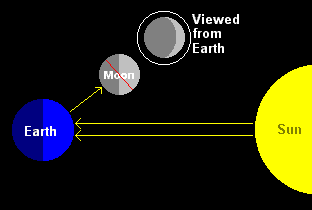 |
.
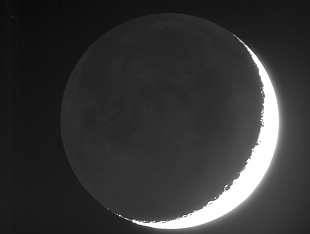
Click the
image to see it in higher resolution (4.36"/pixel). |
Moon
17.06.2007 21:46 - 21:48 (19:46 - 19:48 UT)
Resolution: 8.72 arcsec/pixel
Camera: Lumenera
Lu075M (Monochrome), in 12-bit mode
Telescope: Meade ETX-70AT
achromatic refractor
Filters: IR blocking filter
Result focal length: 350 mm
Result focal ratio: F5
Exposure: 974 x 66.75ms (~1/15s), 15 fps
Camera settings: Gain 4.00; Gamma 1.00;
Brightness 0.00; Contrast 1.00
Captured and processed: K3CCDTools 3I
captured 2 AVI files in 12-bit mode (12-bit K3CC codec).
After stacking I used strong gamma (2.5) to
emphasize the dark part of the Moon.
Large stack size and 12-bit depth allowed me to
extract also details in dark part (better visible
on full size image - click the image to see it).
|
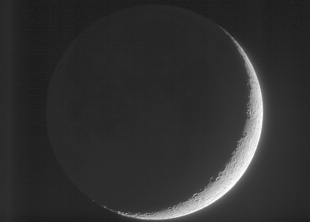
Click the
image to see it in higher resolution (4.36"/pixel). |
Moon 17.06.2007
21:43 - 21:44 (19:43 - 19:44 UT)
Resolution: 8.72 arcsec/pixel
Camera: Lumenera
Lu075M (Monochrome), in 12-bit mode
Telescope: Meade ETX-70AT
achromatic refractor
Filters: IR blocking filter
Result focal length: 350 mm
Result focal ratio: F5
Exposure: 669 x 5.0ms (1/200s), 15 fps
Camera settings: Gain 1.75; Gamma 1.00;
Brightness 0.00; Contrast 1.00
Captured and processed: K3CCDTools 3The
same night as the above, but I wanted to capture
moon without saturation. After stacking 12-bit
AVI file (12-bit K3CC
codec) I used strong gamma (4.0) to
emphasize the dark part of the Moon.
The dark part of the Moon is much less visible
because of shorter exposure and less gain than in
above photo.
|
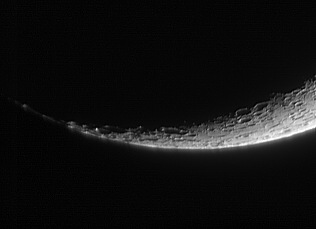
Click the
image to see it in higher resolution (1.45"/pixel). |
Moon
17.06.2007 21:37 (19:37 UT)
Resolution: 2.90 arcsec/pixel
Camera: Lumenera
Lu075M (Monochrome), in 12-bit mode
Telescope: Meade ETX-70AT
achromatic refractor
Filters: IR blocking filter
Result focal length: 1050 mm
Result focal ratio: F15
Exposure: 301 x 66.75ms (~1/15s), 15 fps
Camera settings: Gain 2.50; Gamma 1.00;
Brightness 0.00; Contrast 1.00
Captured and processed: K3CCDTools 3The
same night as the above - I wanted to capture the
south corner in more detail.
|
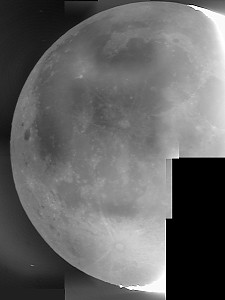
Click the
image to see it in higher resolution (3.14"/pixel). |
Moon
18.03.2002 19:27 - 19:37 (18:27 - 18:37 UT)
Mosaic
Resolution: 6.28 arcsec/pixel
Camera: Philips
Vesta 675SC at
prime focus with 0.60FR
Telescope: 8"
F6 Orion Optics Europa Newtonian
Result focal ratio: F3.6
Exposure: each mosaic plate was stacked 10x3s (gain
50%), 10xDF
Seeing: averaged, temperature 9°CThis
is mosaic of "dark side" of the Moon.
The mosaic is not complete because of strong
light reflections in optical system. These
reflections didn't allow me to capture central
part of Moon.
Note the star in the bottom left corner (TYC 654
1618 1; 9.3mag). The trailing star shows the
apparent movement of Moon during 30 seconds (=10x3s).
|
Back to Main
Moon Page
Computer generated images,
real images, drawings and texts are property of the
author and may not be reproduced or used without
permission of author.

Last Update:
27.06.2007
|